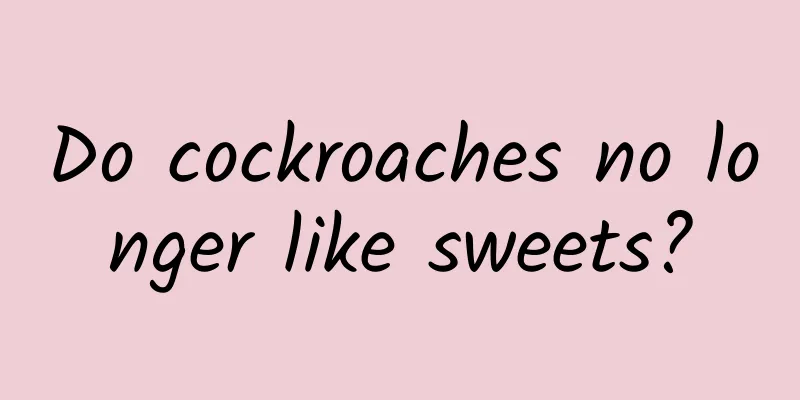Do cockroaches no longer like sweets?

|
When you pick up the dirty laundry basket in the bathroom, a black unknown creature moves quickly and crawls into the next dark corner amid your screams. I believe many people are familiar with this scene. Facing cockroaches, friends in the south may be accustomed to it, but children in the north will still have a sharp rise in blood pressure every time they see one. As one of the four pests, cockroaches are not big in size, but they can cause great harm. They can carry and spread a variety of pathogens (such as Shigella dysenteriae, Escherichia coli) and insect eggs (such as roundworms, nematodes) through the intestinal cavity and body surface, thereby causing a variety of diseases in humans. Even their excrement and body debris can become allergens for some friends, inducing asthma and allergies. Cockroach with egg case Image source: entomologytoday.org In order to eliminate these "harmful forces" in the home, humans have used a variety of methods, such as sticky insect boards, insecticide sprays, and insecticide baits. However, in the process of fighting wits and courage with humans, cockroaches have also evolved corresponding methods to escape from the baits... 1. Cockroaches: I have given up sugar, please do not disturb me Everyone must be familiar with cockroach bait. Since the 1980s, people have begun to use poisonous bait to kill cockroaches. The bait usually consists of insecticide ingredients and attractants, such as glucose or fructose. After eating this poisonous bait, cockroaches generally do not die immediately, but will die of the poison after returning to the nest. If other cockroaches in the same nest eat their corpses or excrement, they may be "killed in one pot". But as the saying goes, "The higher the virtue, the higher the evil." Faced with deadly intestinal poisons, cockroaches are not helpless. In 1993, a study published in the Journal of Insect Physiology reported an interesting phenomenon: a type of cockroach called German cockroach no longer flocks to bait containing glucose, but instead stays away from glucose. This new behavioral trait is called glucose aversion by scientists. Glucose aversion can prevent cockroaches from eating bait containing glucose, thus making the method of killing cockroaches with bait no longer ineffective. You can watch the two videos below. The first video shows wild cockroaches. When faced with glucose and fructose, wild cockroaches have no obvious preference and will run over to "eat" as long as there is sugar. Video 1: Wild-type cockroaches feeding on glucose and fructose Source: Reference 2 In the second video, we can clearly see that the cockroaches with glucose aversion traits avoid glucose and only feed on fructose. Video 2: Glucose-averse cockroaches only eat fructose Source: Reference 2 It’s worth mentioning that this behavioral trait is heritable in cockroaches. Although cockroaches that hate glucose grow and reproduce slower than wild types, growing slowly is not a bad thing compared to dying from swallowing bait, right? However, for cockroaches, although glucose aversion prevents them from being poisoned by the bait, as the saying goes, "good and bad go hand in hand", when you gain something, you may also lose something else, such as love. 2. Without sweetness, will there still be love? Let's first review the courtship process of German cockroaches. During the breeding season, mature female German cockroaches will synthesize a contact pheromone in their bodies. When male cockroaches encounter the same species, they will use their antennae to touch the other's body to determine whether the other is a mature female that can mate. If the answer is affirmative, the male will offer his "bride price" to the female: the male will change the angle of his body, turn the abdomen toward the female, and then expose his back to secrete pheromones. When the female comes forward to lick the pheromones, the male will take the opportunity to mate with the female. This "love affair" seems to have nothing to do with glucose aversion, right? In fact, the sex pheromone that the male insect uses to attract the female insect contains chemicals such as sugar and lipids, which have high nutritional value. That's why it is jokingly called the "bride price" offered by the male insect. This pheromone can not only attract the female insect to complete mating, but also provide nutrition to the female insect and promote the development of fertilized eggs. But for female insects that hate glucose, such nutrient-rich pheromones are very "disgusting", just like poisonous bait. How can they swallow them? The escaped female "sugar quitter" Photo source: Veer Gallery Just this year, a research paper published in the journal Communications Biology found that the evolution of behavioral characteristics of German cockroaches caused by poison baits helped them escape the fate of being poisoned to death, but also disrupted their courtship behavior. Two types of female cockroaches react differently to male pheromones. Image source: Reference 3 Researchers pointed out that because cockroach saliva can quickly break down complex sugars, when the female licks the male's pheromone, it converts the sugar in the pheromone into glucose. Then, the bitterness in the mouth makes the female stop licking and run away... I guess the people who developed the poison bait didn't expect that the poison bait would actually affect the cockroach's courtship behavior? 3. Human-driven evolution From a scientific point of view, the story of the evolution of glucose aversion in German cockroaches shows how humans drive the process of evolution. In fact, it is not just cockroaches. Humans have exerted very strong selection on the animals around them, from poultry and livestock to pets at home. Human directional selection has caused animals to respond quickly in both physiology and behavior. For example, the differences between dog breeds can be said to be very different. In terms of body size alone, the largest dog in the world can stand more than 2 meters tall, while the smallest dog is only 15 centimeters long. In addition, strong artificial selection has also made different dog breeds show great diversity in body size, head shape, coat color, coat quality, ear shape and other traits. It can be said that dogs have started a wild run on the road of evolution. Image source: Science But what could be worse for people than cockroaches not eating the bait? References: Silverman, J., & Bieman, DN (1993). Glucose aversion in the German cockroach, Blattella germanica. Journal of Insect physiology, 39(11), 925-933. Wada-Katsumata, A., Silverman, J., & Schal, C. (2013). Changes in taste neurons support the emergence of an adaptive behavior in cockroaches. Science, 340(6135), 972-975. Wada-Katsumata, A., Hatano, E., McPherson, S., Silverman, J., & Schal, C. (2022). Rapid evolution of an adaptive taste polymorphism disrupts courtship behavior. Communications biology, 5(1), 1-10. Produced by: Science Popularization China Author: EVEE (School of Life Sciences, Peking University) Producer: China Science Expo |
Recommend
Analysis of competing products for 618 events on Tmall, JD.com and others!
This article will analyze the 618 activities of o...
The mysterious octopus species is actually most similar to humans?
Leviathan: Compared to the soft body of the octop...
The first developer preview of Android 14
Making Android work well for each of the billions...
What is so special about oysters that they have been praised by the most talented foodie in history?
Su Shi, a great writer and calligrapher in the No...
By deploying large models on chips, how does Alibaba Cloud reshape the AI mobile phone experience through end-cloud collaboration?
In an age where smartphones have become almost an...
APIs you must know in Html5
The following is a summary of some HTML APIs that...
The battle of billions of pixels: What are the mobile phone manufacturers competing for?
Recently, Xiaomi introduced Samsung's first 6...
Taiwan Industrial Technology Research Institute: Top Ten ICT Key Reports in 2016
ITRI proposes the top ten key ICT industry topi...
Earn 50 yuan in half an hour, try the monetization ability of PPT! How much does it usually cost to make a PPT?
It's a new week. I believe many people check ...
She made a decision that "went against her ancestors' teachings" and then advanced a discipline by decades.
In "He was a doctor, but he changed astronom...
Behind the rumors of Google entering China: the market structure has been determined or it may not adapt to the local environment
[[149992]] "Is Google Play really going to e...
Eight car brands suddenly recalled 770,000 vehicles on the eve of March 15
March 15 is a Chinese event, especially for the a...
Every drop of alcohol you drink is damaging your brain!
【Written at the end】 In 2018, a study in The Lanc...
Why is diarrhea after eating spicy food becoming more and more common?
This article was reviewed by Pa Li Ze, chief phys...









